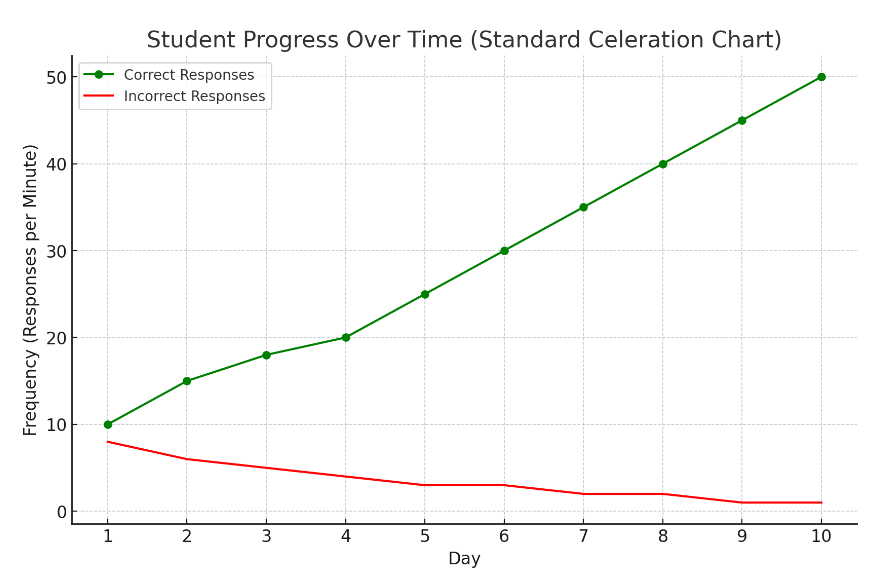Precision Teaching is a powerful, data-driven instructional method that emphasizes fluency and mastery of skills through continuous monitoring and measurement of student performance. Rooted in behavior analysis, Precision Teaching has demonstrated success in improving learning outcomes across a variety of academic and behavioral domains. This guide provides a step-by-step approach for educators who wish to implement Precision Teaching in their classrooms effectively.
Step 1: Define Clear Learning Objectives
The first step in implementing Precision Teaching is to define specific and measurable learning objectives. These objectives should be clear, attainable, and aligned with curriculum standards. The focus of Precision Teaching is on fluency, which means that students should not only understand a concept but also perform the related skills quickly and accurately.
Examples of learning objectives:
- Increase reading fluency by reading 100 words per minute with 95% accuracy.
- Solve 20 basic multiplication problems in under two minutes with 90% accuracy.
These learning goals provide a clear target for both students and educators to track progress throughout the learning process.
Check out our Free English/Literacy Worksheet Generators
Step 2: Select Appropriate Measures
Once the learning objectives are established, it’s essential to choose appropriate measures to assess student progress. These measures should be reliable, valid, and aligned with the learning goals. In Precision Teaching, performance is often measured using frequency-based data (i.e., how often a correct response occurs within a set period).
Types of measurement tools:
- Timed Assessments: Timed tasks are ideal for measuring fluency. For example, timed reading passages for assessing reading fluency or timed math fact drills for measuring math fluency.
- Curriculum-Based Measures (CBM): These short, frequent assessments are designed to track student progress and measure proficiency in various skills.
The chosen measures should be easy to administer and repeat, as frequent data collection is a cornerstone of Precision Teaching.
Step 3: Collect Baseline Data
Before any instructional interventions are implemented, it’s crucial to collect baseline data on students’ current performance levels. This data serves as a starting point for tracking progress and making informed instructional decisions.
How to collect baseline data:
- Administer a timed assessment or task related to the learning objective.
- Record the number of correct and incorrect responses within the allotted time.
- Document this baseline data on a chart or tracking sheet.
Baseline data provides a clear picture of where each student is starting and helps set realistic goals for improvement.
Step 4: Develop and Implement Instructional Strategies
With the baseline data in hand, educators can now design and implement targeted instructional strategies. Precision Teaching is flexible and can be used in various instructional formats, from one-on-one tutoring to whole-class lessons.
Tips for developing instructional strategies:
- Personalize Instruction: Tailor lessons based on each student’s needs and performance data. For example, if a student struggles with reading speed, provide additional practice with timed reading passages.
- Incorporate Frequent Practice: Encourage students to practice regularly, focusing on both speed and accuracy. Precision Teaching relies on short, daily practice sessions that allow for frequent monitoring of progress.
- Use Positive Reinforcement: Provide immediate feedback and reinforcement to encourage progress. This could involve praise, rewards, or self-tracking charts where students can monitor their own growth.
Precision Teaching emphasizes small, incremental improvements. Break down complex skills into smaller, manageable components for students to master before moving on to more challenging tasks.
Step 5: Chart Student Progress
A central feature of Precision Teaching is the use of visual data to track student progress. Standard Celeration Charts are commonly used to plot performance data over time. These charts provide a clear visual representation of student growth, helping educators identify trends, patterns, and areas that need attention.
How to use Standard Celeration Charts:
- Plot Frequency Data: Record the frequency of correct and incorrect responses (per minute) on the chart.
- Monitor Changes Over Time: Use the chart to track student progress daily. The slope of the data on the chart indicates whether the student is making progress, staying stagnant, or declining.
- Adjust Instruction Based on Data: If the chart shows little improvement, it’s an indication that the instructional strategy may need adjustment. This might involve increasing practice time, changing the task format, or providing additional support.

These charts make the learning process transparent and provide immediate feedback to both students and educators.
Step 6: Make Data-Driven Adjustments
One of the key benefits of Precision Teaching is its reliance on data for making informed instructional decisions. Based on the data collected, educators can quickly determine whether a student is progressing as expected or if adjustments to the teaching method are needed.
Common adjustments include:
- Increase Practice Opportunities: If students are not achieving fluency, they may need more opportunities to practice the skill.
- Modify the Task Difficulty: If a student is finding a task too easy or too challenging, adjust the level of difficulty to match their abilities.
- Provide Additional Support: Some students may require extra one-on-one instruction or tailored interventions to achieve fluency.
By continually monitoring performance data, educators can ensure that students stay on track and receive the necessary support to succeed.
Step 7: Celebrate Success and Encourage Self-Monitoring
As students make progress, it’s important to celebrate their achievements. Recognition of small victories can boost student motivation and confidence, fostering a positive learning environment.
Ways to celebrate success:
- Use Visual Progress Charts: Allow students to see their own progress by involving them in charting their performance. This empowers students to take ownership of their learning and recognize their growth.
- Offer Rewards or Incentives: Create a reward system where students earn points, certificates, or other incentives for reaching fluency targets.
- Provide Positive Feedback: Verbal praise and encouragement go a long way in maintaining student engagement and motivation.
Additionally, encourage students to engage in self-monitoring. When students track their own progress, they develop a greater sense of responsibility and intrinsic motivation to improve.
Step 8: Review and Reflect
Precision Teaching is an ongoing process that involves continuous reflection and improvement. Periodically, educators should review the data and reflect on the effectiveness of their instructional strategies.
Reflection Questions:
- Are students meeting the fluency targets set for them?
- Which strategies have been most effective, and why?
- Are there any students who are not making expected progress? If so, what additional support can be provided?
- How can the Precision Teaching process be refined to better meet the needs of all learners?
By reflecting on these questions, educators can fine-tune their approach to Precision Teaching, ensuring it remains effective and responsive to student needs.
Try out Free Math and English Worksheet Generators
Precision Teaching offers educators a powerful framework for improving student learning outcomes through data-driven, individualized instruction. By following the steps outlined in this guide—defining clear objectives, selecting appropriate measures, collecting baseline data, developing targeted strategies, and using data to make adjustments—teachers can create a more responsive and engaging learning environment.
When implemented effectively, Precision Teaching not only boosts academic performance but also empowers students to take ownership of their learning journey. With its focus on fluency, frequent measurement, and personalized instruction, Precision Teaching is a proven method for fostering success in the classroom.
